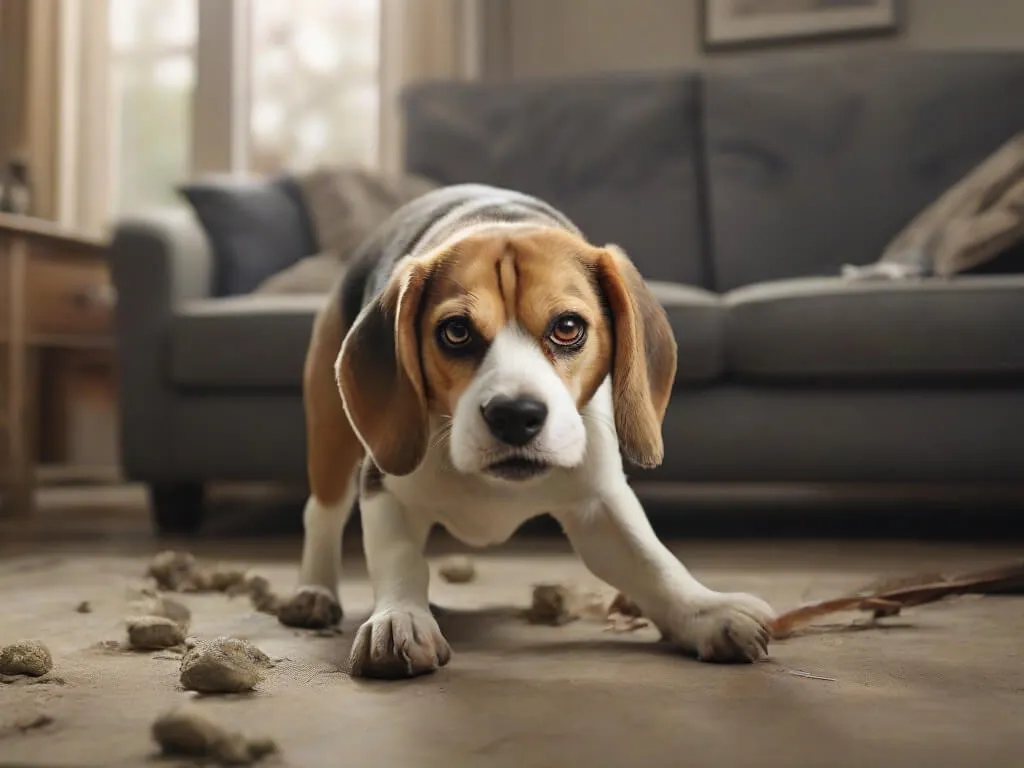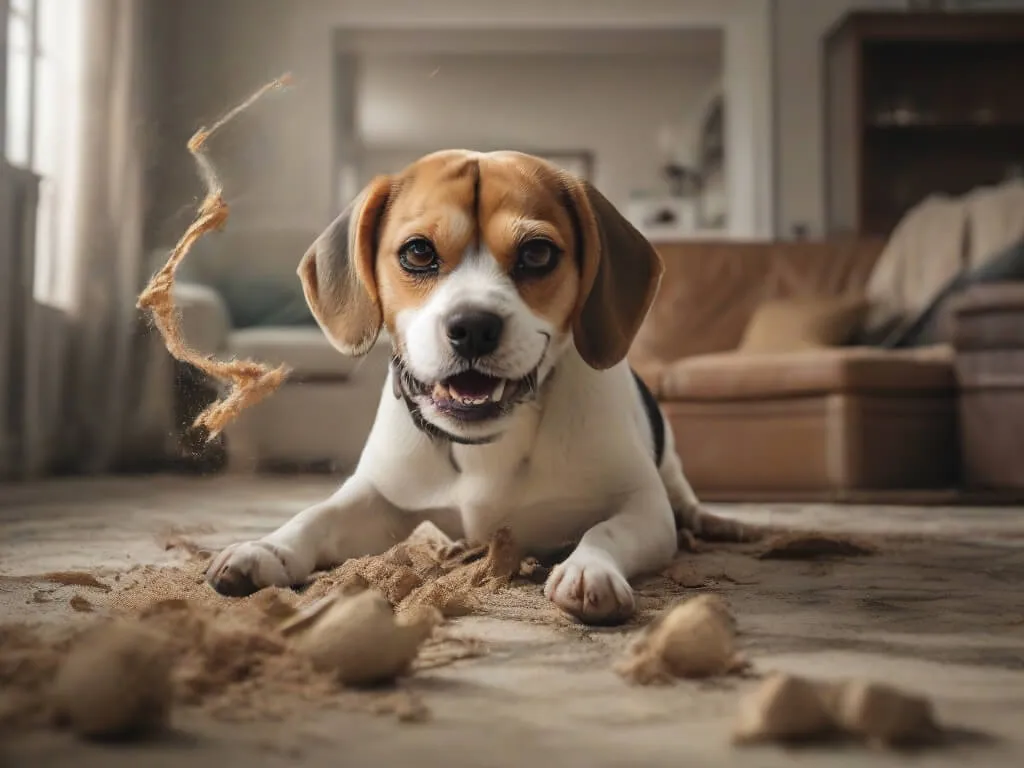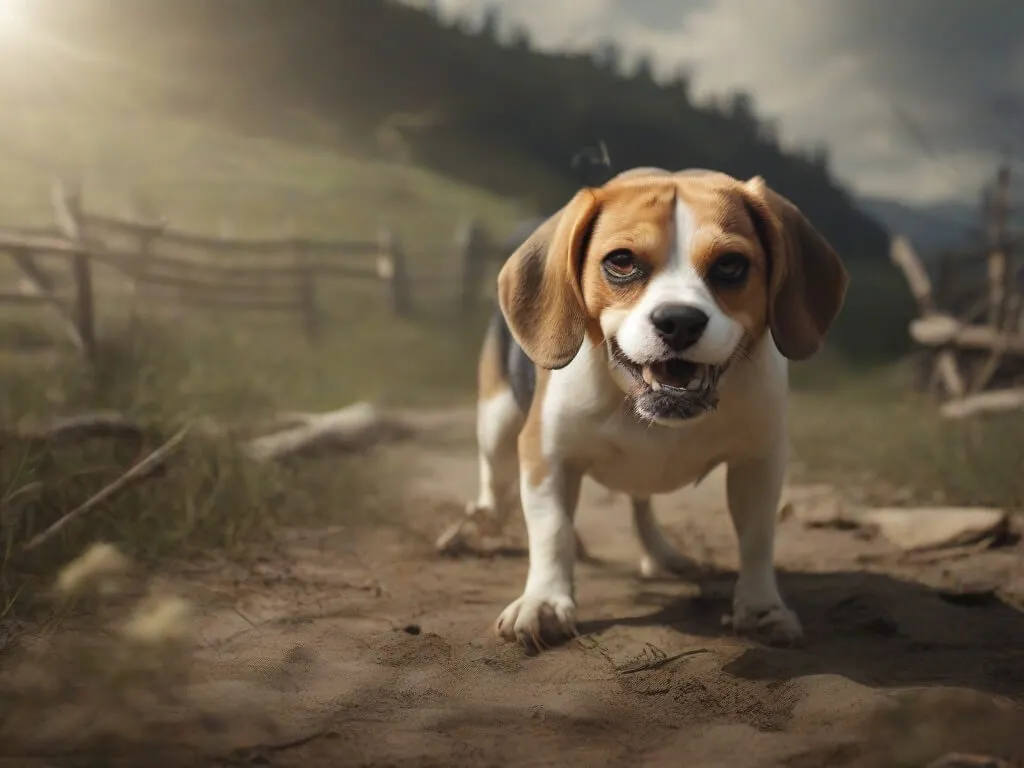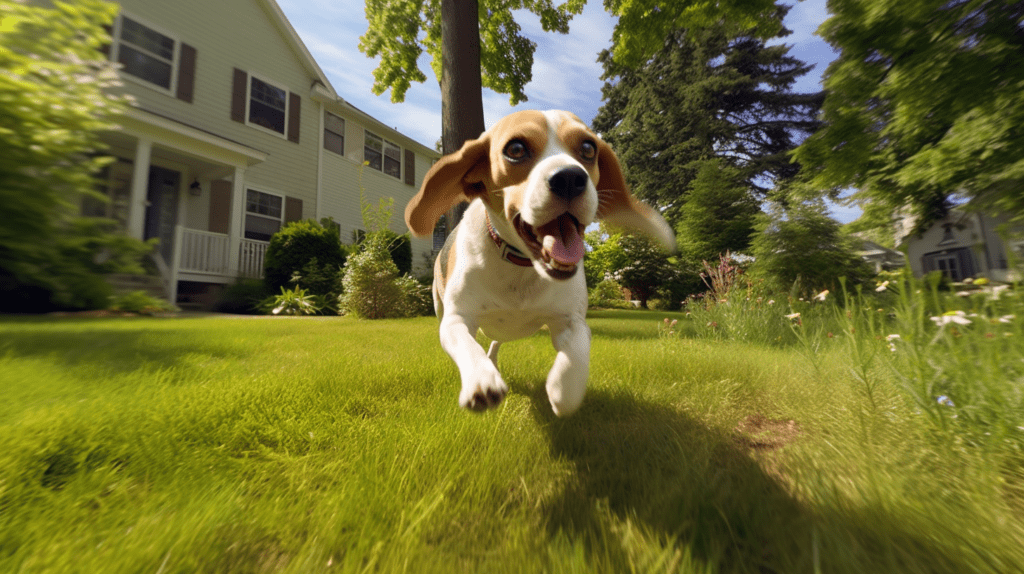Beagles, known for their charming personalities, can sometimes express their zest for life through incessant chewing, also known as beagle chewers. This behavior, while natural, can become problematic, leading many owners to seek effective strategies to curb this habit.
By the end of this article you’ll have a better understanding of why beagles chew and offers practical advice to help manage and redirect their chewing behavior. Ideal for beagle owners, this guide aims to transform your furry friend’s destructive tendencies into positive actions.
Contents
- 1 Why Do Beagles Chew? Understanding the Canine Instinct
- 2 Is Your Beagle Chewing Everything? Signs to Watch For
- 3 Puppy Teething: A Crucial Stage for Your Beagle
- 4 Chew Toys: The Safe Outlet for Your Beagle’s Chewing Needs
- 5 Training Your Beagle: Techniques to Redirect Chewing Behavior
- 6 Separation Anxiety and Chewing: How to Help Your Beagle Cope
- 7 Beagle Chewers: Aggressive Chewing in Beagles
- 8 Supervising Your Beagle: Preventing Unwanted Chewing
- 9 What Can a Beagle Chew On?
- 10 Do Beagles Grow Out of Chewing?
- 11 Why Does My Beagle Destroy Their Toys?
- 12 Adult Beagles and Chewing: Is It Ever Too Late to Train?
- 13 Key Takeaways
Why Do Beagles Chew? Understanding the Canine Instinct


Chewing is a natural and instinctual behavior for beagles, and understanding this is key to managing their chewing habits effectively. Here’s an expanded look at why beagles chew and the factors influencing this behavior:
1. Teething in Puppies: Just like human babies, beagle puppies go through a teething phase where they experience discomfort as their teeth grow. Chewing helps alleviate this discomfort. It’s a critical phase where they explore the world and learn what is (and isn’t) suitable to chew.
2. Exploration and Curiosity: Beagles are naturally curious animals. They explore their environment primarily through their sense of smell and taste. Chewing is a way for them to understand and interact with different objects in their surroundings.
3. Boredom or Lack of Stimulation: If a beagle doesn’t get enough physical or mental exercise, they may resort to chewing as a way to entertain themselves. This is especially true for beagles, a breed known for their high energy levels and intelligence.
4. Anxiety and Stress Relief: For some beagles, chewing can be a coping mechanism to deal with anxiety or stress. Situations like separation from their owners, loud noises, or unfamiliar environments can trigger this kind of stress-related chewing.
5. Natural Instincts: As descendants of wolves, dogs have inherited the instinct to chew. In the wild, chewing is a necessary behavior for survival – it helps in food preparation and keeps their jaws strong. Domesticated beagles retain this instinct, though it’s not needed for survival in the same way.
6. Attention-Seeking Behavior: Sometimes, beagles might chew things to get attention from their owners. This is more common if they’ve learned that chewing results in interaction, even if it’s negative attention.
7. Dental Health: Chewing also plays a role in maintaining good dental health. It helps scrape off plaque and tartar from their teeth, contributing to healthier gums and teeth.
8. Habitual Behavior: Over time, chewing can become a habit for beagles. If they’ve developed a pattern of chewing on certain objects (like shoes or furniture), it can become a regular part of their routine.
In summary, a beagle’s inclination to chew is influenced by various factors, including developmental stages, natural instincts, emotional states, and environmental conditions. Recognizing these reasons is the first step in effectively addressing and redirecting this behavior. Through understanding, patience, and appropriate training and interventions, beagle owners can help their pets develop healthy chewing habits.
Is Your Beagle Chewing Everything? Signs to Watch For
Recognizing Excessive Chewing: Beagle puppies may chew as part of their development, but when does it become a problem? Look for signs like destructive chewing, targeting household items, and persistent gnawing as potential characteristic of your pup being an affiliate chewer.
Addressing the Issue: Early recognition and intervention are key, especially when you notice your beagle may chew in excess. Identifying the root cause, whether it’s boredom or due to teething, aids in applying the appropriate strategy to control the behavior of your beagle who loves to chew.
Puppy Teething: A Crucial Stage for Your Beagle


Puppy teething is an essential developmental stage for beagle puppies, and it’s vital for owners to understand and effectively manage this period. Here’s a deeper look into what the teething stage involves and how you can support your beagle puppy through it:
1. Understanding the Teething Process: Beagle puppies start teething at around 3 to 4 months of age. During this time, their milk teeth (baby teeth) fall out, and their permanent adult teeth begin to emerge. This process can cause discomfort and sometimes pain, leading to an increased need to chew.
2. Signs of Teething: Common signs that your beagle puppy is teething include excessive drooling, chewing more than usual, visible discomfort, and sometimes a mild increase in aggressive behavior due to the pain. You might also find tiny teeth around your home as they fall out.
3. Providing Appropriate Chew Toys: Offering a variety of chew toys is essential during this stage. Teething toys that are soft yet durable can provide relief for sore gums. Some toys can be frozen to provide cooling comfort. Ensure that the toys are safe and size-appropriate to prevent any choking hazards.
4. Managing Discomfort: Besides chew toys, you can also help alleviate your puppy’s discomfort through gentle gum massages. Use a clean finger or a soft pet-specific toothbrush to rub their gums lightly. This can provide a soothing effect.
5. Monitoring Chewing Behavior: While it’s important to allow your beagle puppy to chew during teething, it’s equally important to supervise them. Ensure they are not chewing on harmful objects, and redirect them to appropriate toys whenever necessary.
6. Dietary Considerations: Some puppies might experience a slight change in eating habits due to the discomfort of teething. Providing soft food or soaking kibble in water can make eating more comfortable during this stage.
7. Establishing Good Habits: Teething is an opportune time to teach your beagle what is acceptable to chew on. Consistently guiding them towards appropriate chew toys and away from household items will lay the foundation for good chewing habits.
8. Regular Veterinary Check-Ups: During teething, regular check-ups with a veterinarian are important. They can monitor the progress of the teething process, ensuring all baby teeth are falling out as they should and adult teeth are coming in correctly.
9. Patience and Understanding: It’s crucial to be patient and understanding during your beagle’s teething phase. Remember, this is a temporary stage, and with the right approach, you can help your puppy navigate it with minimal discomfort and stress.
By attentively managing your beagle puppy’s teething stage, you not only help them through a challenging period but also set the stage for healthy dental habits and behaviors in their adult life.
Chew Toys: The Safe Outlet for Your Beagle’s Chewing Needs
Chew toys play a crucial role in managing your beagle’s chewing instincts. Not only do they provide a safe outlet for this natural behavior, but they also contribute to the overall well-being of your pet. Here’s an expanded look at how to effectively use chew toys for your beagle:
Choosing the Right Chew Toys: Selecting the right toys for your beagle is essential. Look for durable, non-toxic materials that can withstand vigorous chewing. Avoid toys with small parts that can break off and pose a choking hazard. Some popular options include rubber chew toys, durable rope toys, and tough nylon bones.
Variety is Key: Beagles can get bored with the same toys, so it’s important to have a variety on hand. Rotating toys regularly can keep your beagle interested and engaged. This variety also helps you discover which types of toys your beagle prefers and which last the longest.
Interactive Chew Toys: Toys that can be filled with treats or food add an extra layer of engagement for your beagle. Puzzle toys or treat-dispensing toys provide mental stimulation as well as a chewing challenge, keeping your beagle occupied and satisfied for longer periods.
Safety First: Regularly inspect your beagle’s chew toys for signs of wear and tear. Damaged toys should be replaced to prevent the risk of ingestion of small pieces. Always supervise your beagle when introducing a new toy to ensure it’s safe for them to use.
Toys for Teething Puppies: If you have a teething beagle puppy, look for chew toys specifically designed for teething. These toys are often softer and help relieve gum discomfort. Freezing these toys can provide additional relief to sore gums.
Chewing as a Learning Tool: Use chew toys to teach your beagle what is appropriate to chew. If they start chewing something they shouldn’t, calmly redirect them to their chew toy. Praise them when they chew on their toys, reinforcing this positive behavior.
Incorporating Playtime: Make chewing a fun activity by incorporating playtime with their chew toys. Engage in interactive play, like tug-of-war, using a durable rope toy. This not only satisfies their need to chew but also strengthens the bond between you and your beagle.
The Role of Chew Toys in Dental Health: Regular chewing on appropriate toys can help in maintaining good dental health. It aids in cleaning teeth and gums, reducing plaque and tartar build-up, and can contribute to fresher breath.
By integrating a variety of appropriate chew toys into your beagle’s routine, you can provide a healthy outlet for their chewing needs, prevent destructive behavior, and contribute to their overall happiness and well-being. Remember to always choose quality, safety, and fun when picking out chew toys for your furry friend.
Training Your Beagle: Techniques to Redirect Chewing Behavior


Separation Anxiety and Chewing: How to Help Your Beagle Cope
Separation anxiety is a common issue in beagles, often manifesting through behaviors like excessive chewing. Understanding and addressing this condition is crucial for the well-being of your pet. Here’s an expanded view on how to help your beagle cope with separation anxiety and associated chewing:
1. Identifying Separation Anxiety: Signs of separation anxiety in beagles include excessive chewing, especially when left alone, along with other symptoms like pacing, whining, barking, and restlessness. These behaviors typically occur shortly after the departure of the owner.
2. Gradual Desensitization: Begin by leaving your beagle alone for short periods and gradually increase the duration. This process helps them get used to being alone without experiencing anxiety. Make departures and arrivals low-key to avoid escalating any anxiety.
3. Creating a Safe Space: Provide a comfortable area where your beagle feels safe when alone, like a crate or a specific room. This space should be associated with positive experiences. Include their favorite toys, a piece of clothing with your scent, and comfortable bedding.
4. Exercise and Mental Stimulation: Ensure your beagle gets plenty of exercise before you leave. A tired beagle is less likely to experience stress and resort to destructive chewing. Mental stimulation through puzzle toys can also keep them occupied when alone.
5. Avoiding Punishment: Punishing your beagle for anxious behavior or chewing can exacerbate their anxiety. Instead, focus on positive reinforcement and understanding.
6. Consistency in Routine: Beagles benefit from a consistent routine. Regular feeding times, walks, and playtime can provide a sense of security and reduce anxiety.
7. Chew Toys and Distractions: Provide a variety of chew toys to keep your beagle engaged when alone. Toys that can be stuffed with food or treats are especially effective as they provide a rewarding activity that lasts for some time.
8. Professional Training and Therapy: In cases of severe separation anxiety, consider seeking help from a professional dog trainer or a veterinary behaviorist. They can offer tailored strategies and, if necessary, medication to help manage the condition.
9. Companionship: Sometimes, having another pet in the home can help reduce separation anxiety. However, this isn’t always a viable solution for everyone and should be considered carefully based on your circumstances.
10. Calming Aids: Products like calming collars, anxiety wraps, or diffusers that release soothing pheromones can be beneficial in managing your beagle’s anxiety.
By understanding the root causes of your beagle’s separation anxiety and implementing these strategies, you can help reduce their stress and the resulting destructive chewing behaviors. It’s important to approach this issue with patience and empathy, recognizing that your beagle’s actions are a result of distress, not defiance.
Beagle Chewers: Aggressive Chewing in Beagles


Aggressive chewing in beagles can be a challenging behavior for owners to manage. It’s important to understand the underlying causes and implement effective strategies to address this behavior. Here’s a closer look at aggressive chewing in beagles and how to manage it:
1. Understanding Aggressive Chewing: Aggressive chewing in beagles is characterized by intense and often destructive gnawing on objects. This can include furniture, shoes, and even walls. It’s crucial to differentiate this from normal chewing behavior, as aggressive chewing often indicates underlying issues.
2. Identifying the Causes: Several factors can contribute to aggressive chewing, including teething in puppies, boredom, anxiety, lack of exercise, and even medical issues. Determining the root cause is essential for addressing the behavior effectively.
3. Addressing Boredom and Lack of Stimulation: Beagles are energetic and intelligent dogs that require regular physical and mental stimulation. Lack of these can lead to aggressive chewing as a form of self-entertainment. Incorporate daily exercise routines, interactive play sessions, and brain games to keep your beagle engaged.
4. Managing Anxiety and Stress: If the aggressive chewing is due to anxiety, particularly separation anxiety, addressing the emotional needs of your beagle is crucial. Techniques like desensitization to triggers, creating a safe space, and calming aids can be helpful.
5. Providing Appropriate Chew Toys: Ensure your beagle has access to a variety of durable chew toys. These toys should be engaging enough to keep their attention and durable enough to withstand aggressive chewing.
6. Training and Commands: Training your beagle to understand commands like “leave it” or “drop it” can be effective in managing inappropriate chewing. Consistent training reinforces what is acceptable to chew and what is not.
7. Regular Vet Check-Ups: Sometimes, aggressive chewing can stem from dental issues or other medical problems. Regular check-ups with a veterinarian can help rule out any health-related causes.
8. Redirecting Chewing Behavior: When you notice your beagle chewing on something inappropriate, calmly redirect them to a suitable chew toy. Consistently doing so can help change their chewing preferences over time.
9. Puppy-Proofing Your Home: For beagle puppies, puppy-proofing your home by removing temptations and hazards can prevent the development of aggressive chewing habits.
10. Professional Help: If the aggressive chewing behavior persists despite these strategies, consulting a professional dog trainer or a behaviorist can provide more personalized solutions.
Addressing aggressive chewing in beagles requires a combination of understanding, patience, and consistent training. By identifying the causes and providing suitable outlets and interventions, you can help your beagle develop healthier chewing habits and enhance your bond with them.
Supervising Your Beagle: Preventing Unwanted Chewing
Effective supervision is key in preventing unwanted chewing in beagles. This involves being attentive to their behaviors and providing guidance to ensure they engage in appropriate activities. Here’s an expanded view on how to supervise your beagle to prevent unwanted chewing:
1. Understanding the Importance of Supervision: Close observation allows you to understand your beagle’s chewing patterns and intervene before they chew on inappropriate items. This proactive approach is especially important in puppies and young dogs who are still learning the rules.
2. Consistent Monitoring: Always keep an eye on your beagle, especially if they have a history of chewing on things they shouldn’t. If you’re unable to supervise, consider using a crate or a safe, confined space with appropriate chew toys.
3. Creating a Chew-Friendly Environment: Make sure your home is stocked with plenty of appropriate chew toys. This will help satisfy their natural urge to chew and keep them away from household items.
4. Redirecting Inappropriate Chewing: If you catch your beagle chewing on something they shouldn’t, calmly redirect them to an appropriate item. It’s crucial to do this immediately to help them make the connection between what they can and cannot chew.
5. Positive Reinforcement: When your beagle chews on their toys instead of forbidden items, praise them. Positive reinforcement makes them more likely to repeat the behavior.
6. Training and Commands: Teach your beagle commands like “leave it” or “drop it.” This training is beneficial for controlling their chewing behavior and can be used in various situations.
7. Addressing Underlying Issues: If your beagle chews out of anxiety or boredom, address these underlying issues. Increase their exercise, playtime, and mental stimulation to reduce boredom-induced chewing.
8. Puppy-Proofing Your Space: For beagle puppies, ensure your home is puppy-proofed. Keep shoes, wires, and other tempting items out of reach. This not only protects your belongings but also keeps your puppy safe.
9. Routine and Structure: Establishing a routine for play, exercise, and relaxation can help your beagle feel more secure and less likely to engage in unwanted chewing.
10. Immediate Correction: When you notice unwanted chewing behavior, correct it immediately but gently. Delayed reactions can confuse your beagle, making it harder for them to understand what they did wrong.
By actively supervising your beagle and employing these strategies, you can effectively prevent unwanted chewing. This not only protects your belongings but also ensures the safety and well-being of your furry companion. Remember, supervision combined with consistent training and positive reinforcement is the key to guiding your beagle towards acceptable chewing habits.
What Can a Beagle Chew On?


Selecting appropriate chew items for your beagle is essential for their dental health, mental stimulation, and to prevent destructive chewing behavior. Understanding what is safe and beneficial for them to chew on can help maintain their overall well-being. Here’s an expanded view on suitable chew options for beagles:
1. Safe Chew Toys: Invest in high-quality, durable chew toys designed specifically for dogs. Look for toys made from non-toxic materials that are tough enough to withstand vigorous chewing but soft enough not to damage their teeth. Rubber toys, nylon bones, and thick rope toys are often good choices.
2. Dental Chews and Treats: Dental chews can help clean your beagle’s teeth, control tartar build-up, and freshen their breath. Ensure that these chews are appropriate for your beagle’s size and always supervise them to prevent choking hazards.
3. Natural Chews: Natural chew options like rawhide, bully sticks, or natural bones can be suitable, but it’s important to choose the right type and size to avoid choking risks and ensure they are digestible. Always supervise your beagle when they have these types of chews.
4. Edible Chew Toys: There are various edible chew toys available that are designed to be consumed safely. These can provide a tasty treat for your beagle while satisfying their urge to chew.
5. Interactive and Puzzle Toys: Toys that challenge your beagle mentally can also be great for chewing. Puzzle toys that dispense treats as they play can keep your beagle engaged and help reduce boredom-related chewing.
6. Frozen Chews: For teething puppies, frozen chew toys or frozen carrots can provide soothing relief for sore gums. The cold helps numb the area, reducing discomfort.
7. Avoid Unsafe Items: It’s important to avoid items that can splinter or break into small pieces, as these can be choking hazards or cause internal damage. Cooked bones, certain types of rawhide, and toys with small, detachable parts should be avoided.
8. Supervision is Key: Always supervise your beagle when they’re chewing something new to ensure they’re safe and not at risk of ingesting something harmful.
9. Variety and Rotation: Keep your beagle interested and engaged by rotating the chew toys available to them. This can prevent boredom and keep them from chewing on inappropriate items.
10. Know Your Beagle’s Chew Style: Some beagles are gentle chewers, while others are more aggressive. Understanding your beagle’s chewing style will help you choose the most suitable and durable toys for them.
By providing your beagle with a variety of appropriate and safe chew options, you can satisfy their natural chewing instincts, maintain their dental health, and prevent destructive behaviors. Remember, the best chew for your beagle is one that they enjoy and that keeps them safe.
Do Beagles Grow Out of Chewing?
The chewing behavior in beagles is a natural instinct that varies in intensity throughout different stages of their life. Understanding this behavior and its progression over time is key for beagle owners. Here’s an expanded look into whether beagles grow out of chewing and how this behavior changes as they age:
1. Puppyhood and Teething: In the puppy stage, beagles chew primarily due to teething, which helps alleviate discomfort from emerging teeth. This phase is marked by intense chewing, but it typically diminishes once all their adult teeth have come in, around the age of 6 months.
2. Adolescent Chewing: Even after teething, adolescent beagles (around 6-18 months old) often continue to chew as they explore their environment and test boundaries. This is also a period of high energy and curiosity, which can contribute to continued chewing.
3. Adult Beagles: As beagles mature into adulthood, their need to chew usually decreases. However, it’s a misconception that they completely grow out of it. Chewing is a natural behavior for dogs of all ages, and adult beagles may still chew for enjoyment, stress relief, or to keep their jaws strong.
4. Boredom and Anxiety: In adult beagles, factors like boredom, anxiety, or lack of exercise can lead to increased chewing. Providing adequate mental and physical stimulation is crucial to prevent destructive chewing in adult dogs.
5. Habitual Behavior: If a beagle has developed a habit of chewing inappropriate items during their younger years and it hasn’t been effectively managed, this behavior can continue into adulthood.
6. Dental Health: Chewing also plays a role in maintaining dental health in beagles. Chewing on appropriate toys or dental chews helps to keep their teeth clean and gums healthy.
7. Importance of Training: Consistent training and providing suitable chew toys throughout a beagle’s life are important in managing and redirecting their chewing behavior. Training helps in establishing what is appropriate to chew and what is not.
8. Individual Differences: Each beagle is unique, and while some may naturally decrease their chewing as they age, others may continue to be avid chewers throughout their lives.
In summary, while the intensity of chewing may decrease as beagles grow from puppies into adults, it is a behavior that, to some extent, remains with them for life. Understanding this and continuing to provide appropriate outlets for chewing is important in ensuring that this natural behavior does not become problematic. Regular engagement, exercise, and mental stimulation remain key components in managing a beagle’s chewing behavior at any age.
Why Does My Beagle Destroy Their Toys?


Many beagle owners wonder if it’s too late to train their adult beagles to curb unwanted chewing habits. The good news is that it is never too late to train an adult beagle, though the approach may differ from training a puppy. Here’s an expanded look at training adult beagles and managing their chewing behavior:
1. Understanding Adult Beagle Behavior: Adult beagles may chew for various reasons, including boredom, anxiety, or simply out of habit. It’s important to understand the specific reasons behind your beagle’s chewing to address it effectively.
2. The Importance of Consistency: Consistency is key in training adult beagles. Consistent rules, commands, and reactions to their behavior help them understand and adhere to what is expected of them.
3. Patience and Persistence: Adult beagles might take longer to unlearn established habits and learn new behaviors. Patience and persistence are crucial. Understand that progress might be gradual and celebrate small victories.
4. Positive Reinforcement Works Best: Use positive reinforcement to encourage desired behavior. Reward your beagle with treats, praise, or playtime when they chew on appropriate items.
5. Redirecting Chewing Habits: If you catch your adult beagle chewing on something inappropriate, gently redirect them to a suitable chew toy. Reinforce the idea that chewing their toys is good while other items are off-limits.
6. Provide Suitable Chew Toys: Ensure that your beagle has access to a variety of chew toys. These should be appropriate for their size and durable enough to withstand their chewing.
7. Address Underlying Causes: If your beagle’s chewing is due to anxiety or boredom, address these underlying issues. Increase their daily exercise, provide mental stimulation, and create a calming environment.
8. Training Classes and Professional Help: Consider enrolling your beagle in obedience classes or hiring a professional dog trainer. These resources can be particularly helpful in providing structured guidance.
9. Health Check-Up: Ensure that there are no underlying health issues contributing to the chewing behavior, especially dental problems, which can cause discomfort and lead to increased chewing.
10. Adjust Expectations: Understand that changing an adult beagle’s behavior may take time. Adjust your expectations and focus on gradual improvement rather than immediate results.
In conclusion, it’s certainly possible to train an adult beagle to modify their chewing behavior. The process requires understanding, patience, and consistency. With the right approach and techniques, you can successfully guide your adult beagle towards healthier chewing habits, enhancing both their well-being and your relationship with them.
Key Takeaways


- Understand the Cause: Identifying the reason behind your beagle’s chewing is the first step towards addressing it.
- Provide Appropriate Chew Toys: These are essential for managing chewing behavior, especially during the teething phase.
- Consistent Training: Positive reinforcement and consistent training are key to teaching your beagle what is acceptable to chew.
- Monitor for Anxiety: Be aware of signs of separation anxiety, which can manifest as chewing.
- Seek Professional Help if Needed: Don’t hesitate to consult a professional for aggressive or persistent chewing issues.
- Supervision is Crucial: Especially for puppies, to prevent unwanted chewing and establish good habits.
- Adapt Training for Adult Beagles: It’s never too late to train, but techniques may need to be adjusted for older dogs.
- Create a Safe Environment: Regularly reassess and adapt your home to keep it safe for your chew-happy beagle.





